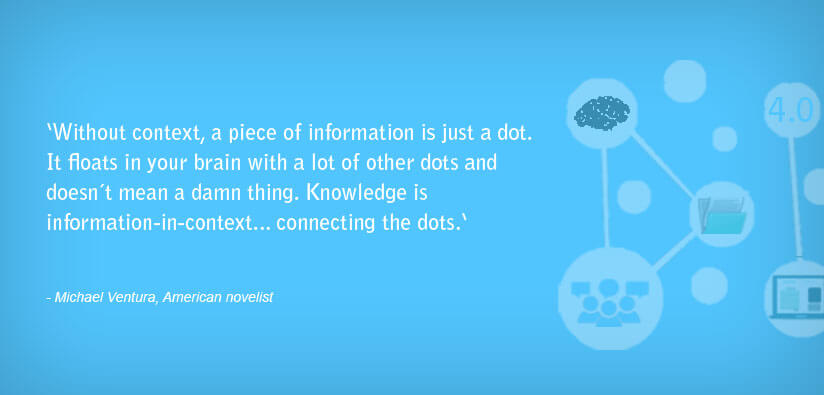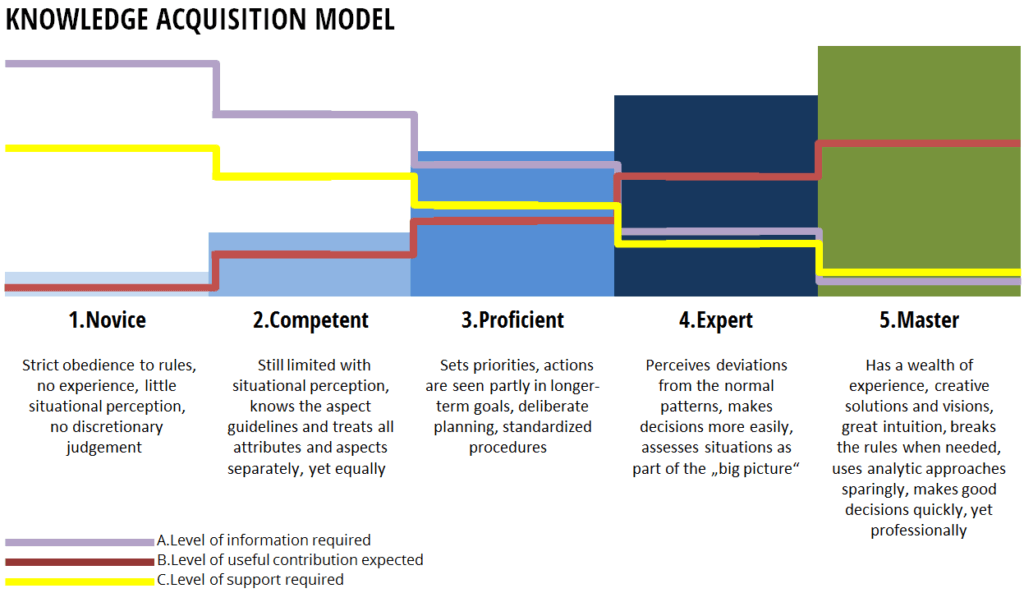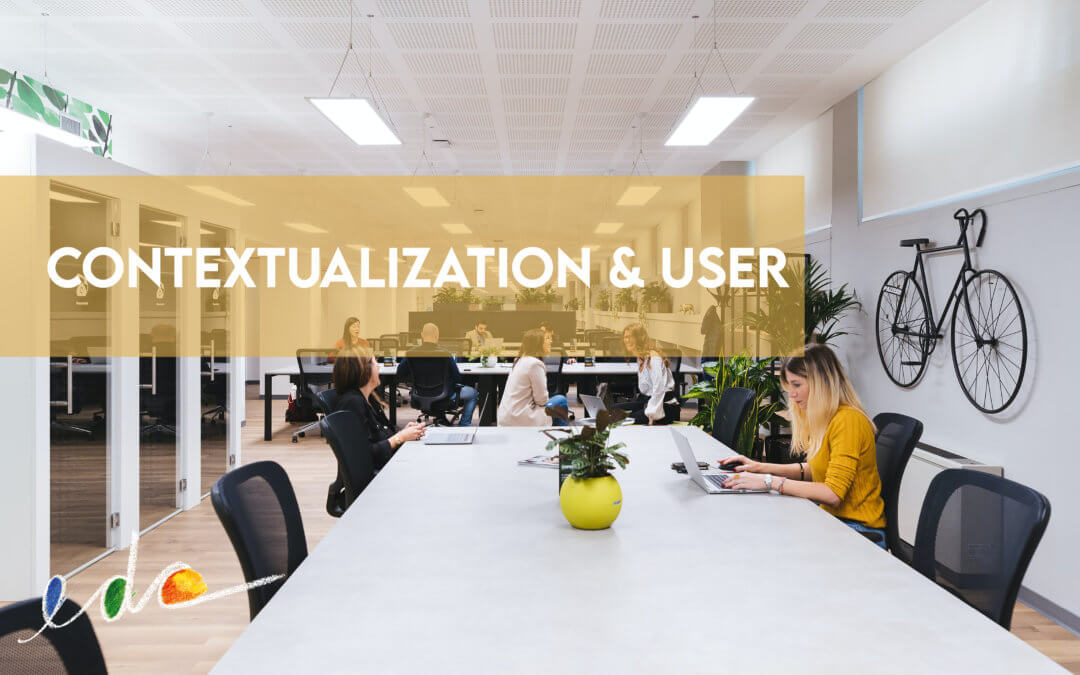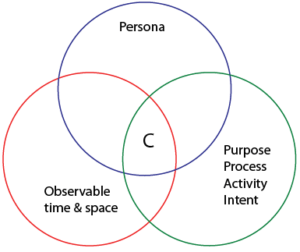In the core definition of Information 4.0, information is molecular, autonomous and profiled. It is also ubiquitous in that it can be present everywhere or anywhere. Contextualization & user experience based on Information 4.0 principles are at the core of our design for edc.
Information in this respect is no longer delivered but amalgamated into “compounds” that are suitable for one specific requirement in one situation. We are at a unique time in the convergence of information technologies with other technology where we can actually envisage this happening.
How we do this is the real question.
Contextual help, in software for instance, is a term that has been around for a long time, but until now it means little more than being able to deliver a block of information based on position to everyone, regardless of the task each is doing. While this is a laudable approach, it is far from the notion of contextualization we would like to see emerge around Information 4.0. To really understand the interaction between contextualization & user experience, we need to define what we mean by contextualization.
What is contextualization?
The term contextualization is found in various domains, some of them surprising. For instance, the concept can be found in missionary efforts, sociolinguistics and computer sciences, just to take three very divergent examples:
- In missionary efforts, contextualization is adapting the form of the message to the target audience. It becomes more acceptable.
- In sociolinguistics, contextualization refers to the use of language and discourse to signal relevant aspects of an interactional or communicative situation. This involves change in format, style, and tone to ease a conversation, for instance.
- In Object-Oriented Programming (OOP), contextualization is very well known. It implies providing adequate initialization parameters to a class constructor. Although we are dealing with information, the notion of initializing a class constructor remains relatively valid. Approaching the subject in this manner, contextualization is about building a prediction based on observable or determined variables.
What we can see is that parts of all three definitions could describe the contextualization needed in Information 4.0, but each remains inadequate for getting the job done if we try to understand context prediction.
Why is context prediction important?
Context prediction is essential to understanding and achieving targeted contextualization & user experience. Information 4.0 is based on molecular information and the assembly of that information into content compounds for a unique purpose. One ambition of Information 4.0 is to provide a unique individual content experience on the fly by understanding the individual, the environment, and the purpose or need. The capacity to assemble a valid content compound requires that information and other content components be made available (information offer) and that a method exists for determining what (and only what) is required (defining the boundaries of the offer).
Let’s consider contextualization in Information 4.0 as a prediction model or algorithm. It will probably end up being a lot more complicated than a simple algorithm, but let’s start by trying to understand it in that way first.
To contextualize, we need to understand context
A context is defined by a set of parameters that can be observed or tracked. In the domain of mobile devices, IoT and their networks, context is built on sensor data. The parameters provided by these sensors are environmental and do not necessarily pertain to the individual and other non-tangible parameters that may describe his context. The area of sensor-driven context prediction has dominated research in the last decade because this is the area where device manufacturers want to make a commercial difference.
Stephan Sigg, a researcher in Context prediction algorithms (1), defines parameter sets that constitute a context:
- Identity: elements that characterize the individual as a user, a social entity, and an organizational entity
- Location: geographical and relative position to known geography
- Time: actual and relative time (before, after…)
- Activity: actions carried out, tasks being accomplished
- Constitution: biological and emotional
- Environment: physical, technological and equipment-related
This is all fine if we want to determine a static context. If we want to refine our offering and provide content that is better adapted to actual needs, we will have to take into account more details in the sets of parameters pertaining to identity and activity.
Context in Information 4.0
Beyond the Sigg model of context, what happens if we try to make information person-oriented (expanding his Identity part) and add a business or use case (defining his Activity part in more detail)? Then the model gets slightly more complex.
We can expand Sigg’s model into three domains:
|
Three components of a context matrix |
|
Overlapping these three domains to achieve a fine-grained context prediction results in determining a context state (C) and a trigger for which information molecules are assembled on the fly into a compound.
Context is a matrix and is not static
So, the context we are interested in determining in Information 4.0 is a unique trigger in a multi-dimensional matrix based on sets of determining factors:
- Persona environment, including persona segmentation, constitution and experience
- Observable time, space and environment
- Purpose, process, activity, intent
Should any one of these determining factors change, then the context state and the trigger potentially changes. This change requires a new set of information molecules.
Context states can be predicted from context
In a lot of cases, the next context states can be predicted, and this will become more and more accurate with deep learning algorithms. If the overall purpose of the information provided is to steer through a workflow, then we can easily imagine that the next states can be mapped.
On the other hand, if the overall purpose is marketing, then the next states will be determined to try to get the persona back on track; this is what marketing chatbots want to do. The next predicted context states will depend on which part of the matrix has priority – the persona, the space/time factor or the overall purpose.
Does the evolution of context states create a journey?
Yes, the evolution of context states is part of the user journey. But is it the only part? The part that a purpose plays determines what the journey looks like. If purpose is less predominant, then the journey is ungoverned. In a lot of cases, the journey will need to remain ungoverned. In all cases, the user journey is oriented or impacted by the user’s own experience (and knowledge), so how do we factor this in and avoid frustration?
Contextualization & user experience
User experience has taken on an entirely commercially biased definition.
Usability.gov provides the following definition (2):
User experience (UX) focuses on having a deep understanding of users, what they need, what they value, their abilities, and also their limitations. It also takes into account the business goals and objectives of the group managing the project. UX best practices promote improving the quality of the user’s interaction with and perceptions of your product and any related services.
While we in the user-oriented part of the tech comm world consider user satisfaction, usability and accessibility to be of prime importance, we do not write to seduce, but rather to inform, improve understanding, and increase experience. So we have to be very careful how we integrate the notion of user experience into our contextualization algorithms.
When we see or hear UX designers deal with building a user experience, we would not necessarily define it in the same manner. Our job is to help users build experience on experience. For this reason, an individual’s level of experience is a defining parameter in context determination, which even Stephen Sigg has not included. Experience is a starting point and not a happening.
Mapping experience is not the same as experience mapping!
In marketing :
an experience map is a strategic tool for capturing and presenting key insights into the complex customer interactions that occur across experiences with a product, service, or ecosystem. At the heart of an experience map lies the customer journey model, an archetypal journey created from an aggregate of all customers going from point A to point B as they attempt to achieve a goal or satisfy a need.
The activity of mapping builds knowledge and consensus across teams and stakeholders, and the map as artefact allows you to create and support better customer experiences. In short, experience mapping is a journey that can involve and impact your entire organization (3).
While in both cases there is an interaction between user experience and journey, what is fundamentally different is the distinction between user and customer (or client). And this is distinguished by the end goal. In the first case (our case in fact), the end goal is success, improved experience, learning, efficiency and faithful users. In the second case, the goal is sales conversion, image, and returning customers. While both goals include a desire to satisfy, that satisfaction cannot be measured in the same manner.
To distinguish these two approaches, tech comm needs to concentrate on mapping the experience during use, while marketing is concerned about what the client experiences emotionally. It may be just semantics, but it is a fundamental semantic difference. In both cases some techniques are shared, e.g. defining personas, charting a course and telling a story, but the measurement of success (cognitive vs. affective) is very different.

Another quote about context: “If Content is King, then Context is God” by Gary Vaynerchuk at his keynote speech at Hubspot’s Inbound 12 conference
Experience can be mapped according to time or to knowledge acquisition. We can imagine that user proficiency increases over time, often by trial and error and repetitive actions. In this case our job is to minimize the trial and error part by providing adapted information in a context, which we no longer have to provide when that context changes. We don’t have to provide the steps for getting to a level of experience if the user has gone beyond that level.
To do so, mapping (user) experience is about creating a model for knowledge acquisition over time.
Mapping knowledge and mapping experience
A simple illustration of the knowledge acquisition, based on the Dreyfus skill acquisition model may help explain what we mean by mapping experience in relation to information.

In this illustration, we hypothesize:
- The lower the level of knowledge, the more rule-based information is required, the less conceptual information is required, the less useful contributions by the user can be leveraged, and the more support time is consumed.
- The greater the level of knowledge, the less adapted information is required, the more useful contribution can be leveraged and the less support time is consumed.
To those who are familiar with knowledge management, there is nothing new here. What we need to examine is how to map these experiences levels to our software usage and later to a matrix of context-oriented parameters, so that they are built into a content offering.
Why deal with experience in contextualization?
So, in our thinking, to enhance contextualization & user experience in software, levels of experience must be mapped to content and tracked with exploitable sensing parameters within the software. Some are easy.
- Novice or first-time access to software can assume any level of knowledge. Using a feature for the first time may be considered novice in terms of experience, but it isn’t so simple. It depends on the complexity of the feature first of all, and the care taken in UI usability. Novice behavior can be presumed in a lot of cases, but it could also be mapped, by measuring hesitation, inaction, etc. This is where “intelligent” conversation bots can intervene.
- Competency is a little bit harder to measure. Is it the length of time used to accomplish a task or the lack of calls to help? This is often the moment when a user, content up to this point with his progress, suddenly realizes how much more he has to learn and gets scared… It’s a real tipping point. It can also continue into proficiency. This model can be refined.
- Proficiency is the use of a product without requiring basic help. There is a balance between expectations and features provided.
- Expert usage is where users have grasped the big picture, but what does this mean? Let’s assume that the level of frustration decreases, but expectations will start to increase. These are the users that software publishers need to pay attention to – they help the software evolve.
- Master usage extends beyond the simple feature offering of a product. This is the zone where frustration creeps back in. With deep understanding, users may begin to recognize the product’s limits and become a resource for product evolution.
The first two levels, novice and competent users, are in zones of drop-out caused by frustration. Experts and masters tend to be the ones who influence major new developments in and around software. Masters are ambassadors if catered to properly in a content feedback loop.
For these reasons, contextualization & user experience must take into account the user’s personal experiences, whatever they may be.
What contextualization is not, and why
On March 16, 2016, Instagram posted a note on its blog that sent the Internet into a frenzy:
“To improve your experience, your feed will soon be ordered to show the moments we believe you will care about the most.”
This is not what we want. While we will try to deal with emotions in contextualization, the Instagram example is about a fixed delivery based on some criteria derived from big data and applied across the board. Contextualization in Information 4.0 is about providing as much adaptation as possible to observed objective criteria and then allowing the user sufficient freedom to choose what he needs from an offer that is broad enough to provide useful choice, and narrow enough to avoid overwhelming him. This is what we mean by contextualization & user experience.
What does contextualization & user experience have to do with edc?
We designed edc to help us take the first steps toward these ideals of contextualization & user experience by delivering molecular information in the context of the user experience. Our roadmap is taking us farther down the context-sensitive user journey. The first step, we’ve achieved: we designed edc for personalized user experience, and we designed it so you can deliver information to your software based on your users’ experiences.
In our own contextualized content within edc, we’ve considered the context matrix and we’re working to improve it every day.
Notes
- 1 Algorithms for context prediction in ubiquitous systems Lecture in WS08/09. Stephan Sigg TU Braunschweig Institute of Operating Systems and Computer Networks www.ibr.cs.tu-bs.de/dus
- 2 https://www.usability.gov/what-and-why/user-experience.html
- 3 From ADAPTIVE PATH’S GUIDE TO EXPERIENCE MAPPING on http://mappingexperiences.com/
- Footnote just for fun: check out this definition of contextualization and grasp the scope of work to be done.




